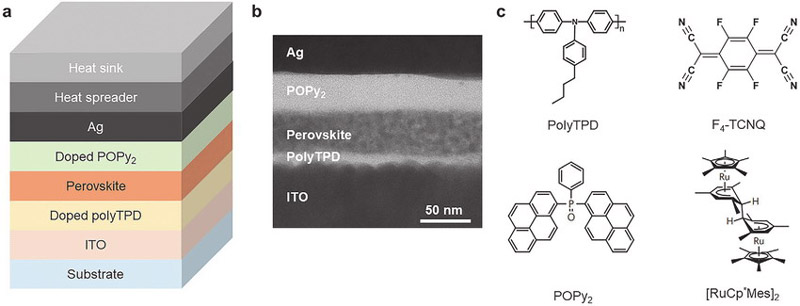NEWS
NEWS
The thermal dissipation of Perovskite LED can be improved to achieve its longer operating time
21-08-2020
In terms of real applications most of the time, Perovskite LED has suffered from frequent failure arising from electrical current typically needed for long time operation. A research team from Princeton University has improved perovskite LED in stability and performance by better achieving the thermal dissipation.

Researchers analyzed several techniques that reduce the increase of heat within the material, which extended its operating time tenfold. In this way, they were able to send enough current to produce light hundreds of times more intense than a typical cell phone display. The intensity, measured in watts per square meter, reflects the real lumen of light coming from a device.
The improvement achieves a new brightness record and surpasses the possible limitation for the material by enhancing the physical properties of perovskite LEDs and allowing those characteristics to be practically used.
To reduce the more and more Joule heat within the device, the researchers redesigned the composition of materials in the device to make it more electrically conductive. They tried to make the devices narrower than usual and added heat sinks, or components that take heat away from sensitive electrical components.After that, they found a solution to quickly turn the device on and off, so fast that a human eye could not see the flicker, but enough time for the device to keep cool. That is to say, by smartly reducing the working time the device, the researchers were able to operate the device longer than before.

Researchers analyzed several techniques that reduce the increase of heat within the material, which extended its operating time tenfold. In this way, they were able to send enough current to produce light hundreds of times more intense than a typical cell phone display. The intensity, measured in watts per square meter, reflects the real lumen of light coming from a device.
The improvement achieves a new brightness record and surpasses the possible limitation for the material by enhancing the physical properties of perovskite LEDs and allowing those characteristics to be practically used.
To reduce the more and more Joule heat within the device, the researchers redesigned the composition of materials in the device to make it more electrically conductive. They tried to make the devices narrower than usual and added heat sinks, or components that take heat away from sensitive electrical components.After that, they found a solution to quickly turn the device on and off, so fast that a human eye could not see the flicker, but enough time for the device to keep cool. That is to say, by smartly reducing the working time the device, the researchers were able to operate the device longer than before.


